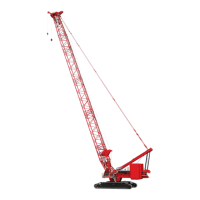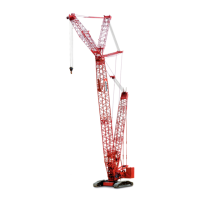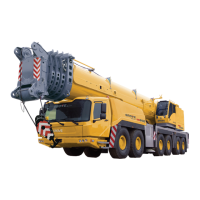ACCESSORIES MLC300 SERVICE/MAINTENANCE MANUAL
10-4
Published 11-22-17, Control # 257-02
LIVE MAST PIN PULLERS
General
This part of Section 10 provides operational information and
electrical and hydraulic schematics for the live mast pin
pullers system.
Additional component information for this system can be
found in the following sections of the Service Manual:
• Section 2: Hydraulics
• Section 3: Electrical
The pins that connect the live mast to the rotating bed are
controlled by the setup remote.
See Figure 10-3
and Figure 10-4 for the following
descriptions.
Setup Remote Control
The setup remote control communicates with the CCM-10
control module via the controller area network bus (CAN
Bus). The crane control modules use the CAN Bus to
communicate with each other.
To operate the setup remote, it must be turned on as
instructed in the MLC300 Operator Manual.
Neutral
When the setup remote is not transmitting:
• Pump 4 hydraulic flow through system A (left valve
assembly) decreases.
• The isolation valve A shifts to neutral to block pump flow
to the live mast pin puller valve.
• The live mast pin puller valve shifts to neutral to block
pump flow to the live mast pin pullers.
Engage (extend)
When an engage command is initiated by the setup remote,
the setup remote receiver communicates the command to
the CCM-10 control module. The CCM-10 control module
then communicates the engage command to the IOLC32
and IOLC33 control modules via CAN Bus C.
The following then occurs:
• The CCM-10 control module increases the PWM current
to pump 4 to increase system A (left valve assembly)
hydraulic flow.
• The IOLC33 control module sends 24 V
DC
to the side A
solenoid on isolation valve A. The solenoid energizes
because the CCM-10 control module provides a ground
for the solenoid. The energized solenoid shifts the valve
spool to a position that routes hydraulic fluid to the live
mast pin puller valve.
• The IOLC32 control module then sends 24 V
DC
to the
corresponding solenoid on the selected live mast pin
puller valve, energizing the solenoid. The valve spool
shifts to a position that routes hydraulic fluid to the barrel
end of the pin puller cylinder.
• As hydraulic fluid flows into the barrel end of the pin
puller cylinder, the rod extends to engage the
corresponding live mast pin. This action forces hydraulic
fluid out the rod end of the pin puller cylinder and back to
the tank via the live mast pin puller valve.
Disengage (retract)
When a disengage command is initiated by the setup
remote, the setup remote receiver communicates the
command to the CCM-10 control module. The CCM-10
control module then communicates the disengage command
to the IOLC32 and IOLC33 control modules via CAN Bus C.
The following then occurs:
• The CCM-10 control module increases the PWM current
to pump 4 to increase system A (left valve assembly)
hydraulic flow.
• The IOLC33 control module sends 24 V
DC
to the side A
solenoid on isolation valve A. The solenoid energizes
because the CCM-10 control module provides a ground
for the solenoid. The energized solenoid shifts the valve
spool to a position that routes hydraulic fluid to the live
mast pin puller valve.
• The IOLC32 control module then sends 24 V
DC
to the
corresponding solenoid on the selected live mast pin
puller valve, energizing the solenoid. The valve spool
shifts to a position that routes hydraulic fluid to the rod
end of the pin puller cylinder.
• As hydraulic fluid flows into the rod end of the pin puller
cylinder, the rod retracts to disengage the corresponding
live mast pin. This action forces hydraulic fluid out the
barrel end of the pin puller cylinder and back to the tank
via the live mast pin puller valve.

